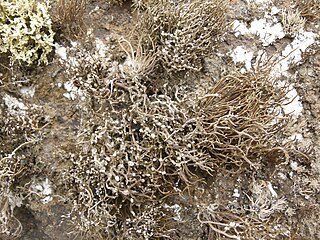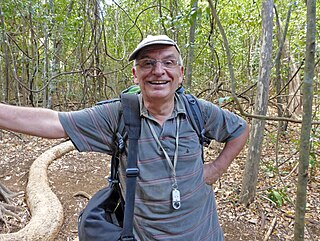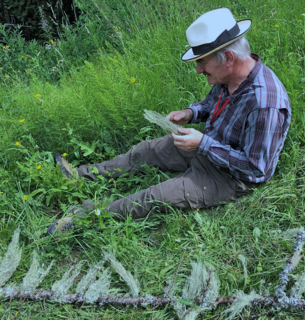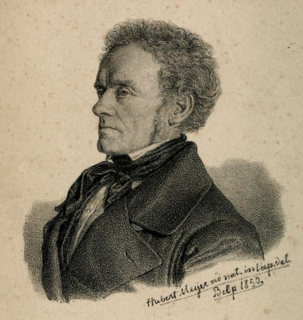
Lichenology is the branch of mycology that studies the lichens, symbiotic organisms made up of an intimate symbiotic association of a microscopic alga with a filamentous fungus.

A lichen is a composite organism that arises from algae or cyanobacteria living among filaments of multiple fungi species in a mutualistic relationship. Lichens have properties different from those of their component organisms. They come in many colors, sizes, and forms and are sometimes plant-like, but are not plants. They may have tiny, leafless branches (fruticose); flat leaf-like structures (foliose); grow crust-like, adhering tightly to a surface (substrate) like a thick coat of paint (crustose); have a powder-like appearance (leprose); or other growth forms.

The Cladoniaceae are a family of lichenized fungi in the order Lecanorales. It is one of the largest families of lichen-forming fungi, with about 560 species distributed amongst 17 genera. The reindeer moss and cup lichens (Cladonia) belong to this family. The latter genus, which comprises about 500 species, forms a major part of the diet of large mammals in taiga and tundra ecosystems. Many Cladoniaceae lichens grow on soil, but other can use decaying wood, tree trunks, and, in a few instances, rocks as their substrate. They grow in places with high humidity, and cannot tolerate aridity.
Jamesiella scotica is a species of lichen that is thought to be endemic to the United Kingdom and Ireland. In the UK it occurs in montane habitats in England, Wales and Scotland at heights of over 200 metres, thriving on decomposing bryophytes on base-rich soils.
Olivier Jules Richard was a French botanist, mycologist and lichenologist who published on the anatomy and symbiosis of lichens.

The Lecanoraceae are a family of lichenized fungi in the order Lecanorales. Species of this family have a widespread distribution.

The Baeomycetales are an order of mostly lichen-forming fungi in the subclass Ostropomycetidae, in the class Lecanoromycetes. It contains 8 families, 33 genera and about 170 species. As a result of molecular phylogenetics research published in the late 2010s, several orders were folded into the Baeomycetales, resulting in a substantial increase in the number of taxa.

The Verrucariaceae are a family of mostly lichenised fungi in the order Verrucariales. The lichen-forming species have a wide variety of thallus forms, and include crustose (crust-like), foliose (bushy), and squamulose (scaly) representatives. There are several dozen lichenicolous (lichen-dwelling) examples in the family, and some genera that contain solely lichenicolous members. An unusually wide variety of photobiont partners have been recorded, mostly green algae, but also brown algae and yellow-green algae. The family, circumscribed nearly two centuries ago, now includes 56 genera and over one thousand species. Most diversity occurring in the temperate climates of the Northern Hemisphere. Rocks and soil are the most common substrates for the Verrucariaceae, with growth on wood and bark less common. Some semi-aquatic lichens occur in this family, including about two dozen species of marine lichens.

Ferdinand Christian Gustav Arnold was a German lichenologist and taxonomist born in Ansbach, Bavaria. Even as a high school student he showed an active interest in botany: "Ich und August Gattinger ... durchstreiften von November 1846 bis zum Spätherbst 1847, Pflanzen sammelnd, die Landschaft von München nach allen Richtungen.".

Grands-Jardins National Park is a provincial park, located in the Unorganized Territory of Lac-Pikauba, in the Charlevoix Regional County Municipality, an administrative region of Capitale-Nationale, in Quebec, Canada.

Roccella tinctoria is a lichenised species of fungus in the genus Roccella, homotypic synonym of Lecanora tinctoria (DC.) Czerwiak., 1849. It was first described by Augustin Pyramus de Candolle in 1805. It has the following varieties:

The Caliciaceae are a family of mostly lichen-forming fungi belonging to the class Lecanoromycetes in the division Ascomycota. Although the family has had its classification changed several times throughout its taxonomic history, the use of modern molecular phylogenetic methods have helped to establish its current placement in the order Caliciales. Caliciaceae contains 36 genera and about 600 species. The largest genus is Buellia, with around 300 species; there are more than a dozen genera that contain only a single species.
André Aptroot is a Dutch mycologist and lichenologist.
Marie-Agnès Letrouit-Galinou is a French botanist, mycologist, and lichenologist, known for her contribution to revolutionizing the scientific understanding of ascomycete development and classification.

Emmanuël Sérusiaux is a Belgian lichenologist. His career, spanning more than four decades, has combined both lichenology research and political aspects of nature conservation. He spent several periods working as a researcher at the National Fund for Scientific Research and the University of Liège, the latter in which he accepted a faculty position as professor and head of the Plant Taxonomy and Conservation Biology unit. Sérusiaux also served for three non-consecutive appointments as Deputy Chief of Staff in the Government of Wallonia. He retired from both his academic and political positions in 2019.
Maurice Gustave Benoît Choisy was a French mycologist and lichenologist. He was a member of the Botanical Society of France, the Mycological Society of France, and the Linnean Society of Lyon. He was president of the botanical section of the latter society from 1949 to 1950.

Philippe Clerc is a Swiss lichenologist. A Festschrift was dedicated to him in 2020, on the occasion of his retirement from the Conservatory and Botanical Garden of the City of Geneva, where he worked from 1993 to 2020. Clerc is an authority on the beard lichens, and has had nearly 100 publications on this and other topics, such as the lichen flora of Switzerland.
Maurice Léopold Joseph Bouly de Lesdain was a French botanist and lichenologist.

Ludwig Emanuel Schaerer was a Swiss pastor and lichenologist. Interested in natural history from a young age, Schaerer trained as a teacher and studied theology in Bern. During his career as a teacher, orphanage director, and pastor, he researched extensively and maintained correspondence with foreign botanists interested in cryptogams. Schaerer was best known for his multi-volume work Lichenum Helveticorum Spicilegium, published in 12 parts from 1823 to 1842. This series catalogued and described the lichens of Switzerland, particularly those in the Alps, where he often went on collecting excursions. In another series, he compiled and distributed dried herbarium specimens acquired from his collections. Several lichen taxa have been named in honour of Schaerer.













